A mix of computer simulations and gamma-ray burst observations shed new light on merging neutron stars.
Astronomers trawled through archival observations of short gamma-ray bursts (GRBs) and detected the rapid evolution of two merging neutron stars into a superheavy neutron star, which then collapsed into a black hole.
Two neutron stars merge to create a black hole.
NASA
This entire process lasted only a fraction of a second, a blog post from NASA explains, and it can teach us a great deal about the transient nature of neutron stars and the evolution of colossal black holes.









Comments are closed.